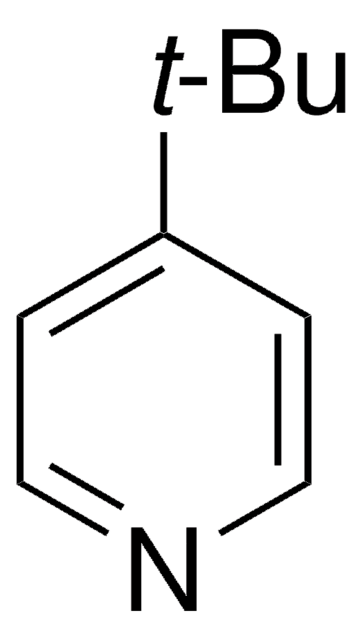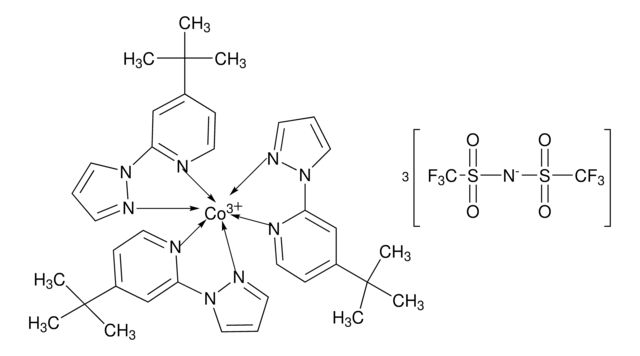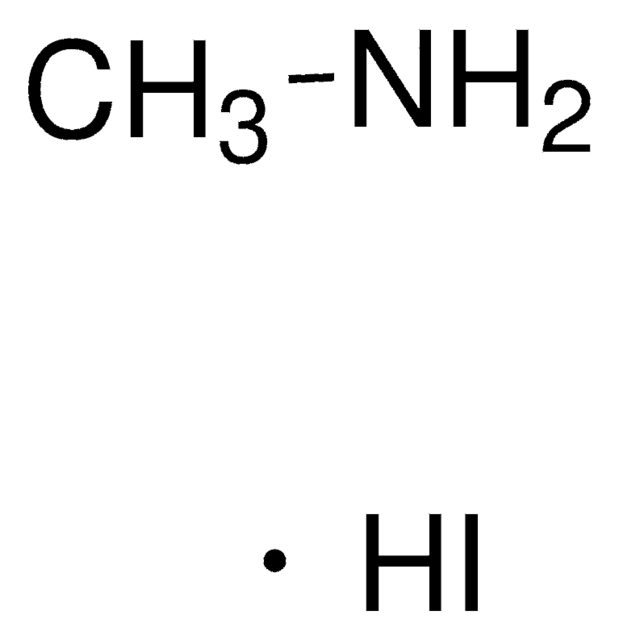Kluczowe dokumenty
923192
Spiro-TTB
≥99% (HPLC)
Synonim(y):
2,2′,7,7′- tetrakis(N,N′-di-p-metylofenyloamino)-9,9′-spirobifluoren, 2,2′,7,7′-tetra(N, N-di-tolilo)amino-spiro-bifluoren, 2,2′,7,7′-tetra(N,N-di-p-tolilo)amino-9,9-spirobifluoren, 2,2′,7,7′-tetra(N,N-ditolilo)amino-9,9-spiro-bifluoren, 2,2′,7,7′-tetrakis(di-p-toliloamino)-9,9′-spirobi[fluoren], 2,2′,7,7′-tetrakis(di-p-toliloamino)spiro-9,9′-bifluoren, N2,N2,N2′,N2′,N7,N7,N7′,N7′-Okta-p-tolilo-9,9′-spirobi[fluoreno]-2,2′,7,7′-tetraamina
About This Item
Polecane produkty
opis
PL:409 nm (in THF)
TGA:> 360 °C (0.5% weight loss)
Tg: 146 °C
Poziom jakości
Próba
≥99% (HPLC)
masa cząsteczkowa
average mol wt 1097.43 g/mol
charakterystyka ekologicznej alternatywy
Design for Energy Efficiency
Learn more about the Principles of Green Chemistry.
sustainability
Greener Alternative Product
strata
0.5% TGA, >360°C
temp. przejścia
Tg 146 °C
rozpuszczalność
THF: soluble
λmaks.
385 nm in THF
Energia orbitalna
HOMO 5.2 eV
LUMO 1.9 eV
kategoria ekologicznej alternatywy
, Enabling
Szukasz podobnych produktów? Odwiedź Przewodnik dotyczący porównywania produktów
Opis ogólny
Zastosowanie
Został z powodzeniem zastosowany jako przezroczysta warstwa przepuszczająca dziury w ogniwach słonecznych, organicznych tranzystorach polowych (OFET) i organicznych urządzeniach emitujących światło (OLED). W fotowoltaice, spiro-TTB został użyty jako organiczna warstwa selektywna dziur pomiędzy perowskitem a ogniwami krzemowymi, przyczyniając się do uzyskania 25,2% sprawności perowskitowo-krzemowego tandemowego ogniwa słonecznego. Zastosowany w diodach OLED, spiro-TTB umożliwił aplikacje w organicznych fotodetektorach (OPD), obrazowaniu i aplikacjach lasingowych.
Kod klasy składowania
11 - Combustible Solids
Klasa zagrożenia wodnego (WGK)
WGK 3
Temperatura zapłonu (°F)
Not applicable
Temperatura zapłonu (°C)
Not applicable
Wybierz jedną z najnowszych wersji:
Certyfikaty analizy (CoA)
It looks like we've run into a problem, but you can still download Certificates of Analysis from our Dokumenty section.
Proszę o kontakt, jeśli potrzebna jest pomoc Obsługa Klienta
Masz już ten produkt?
Dokumenty związane z niedawno zakupionymi produktami zostały zamieszczone w Bibliotece dokumentów.
Produkty
Dr Perini i profesor Correa-Baena omawiają najnowsze badania i wysiłki zmierzające do uzyskania wyższej wydajności i stabilności materiałów perowskitowych.
Nasz zespół naukowców ma doświadczenie we wszystkich obszarach badań, w tym w naukach przyrodniczych, materiałoznawstwie, syntezie chemicznej, chromatografii, analityce i wielu innych dziedzinach.
Skontaktuj się z zespołem ds. pomocy technicznej





![Di-[4-(N,N-di-p-toliloamino)-fenylo]cykloheksan ≥97% (HPLC)](/deepweb/assets/sigmaaldrich/product/structures/111/787/16bde1ce-c76d-46d6-9e1f-9ce09f82d038/640/16bde1ce-c76d-46d6-9e1f-9ce09f82d038.png)

